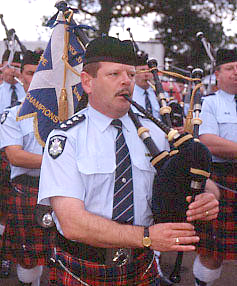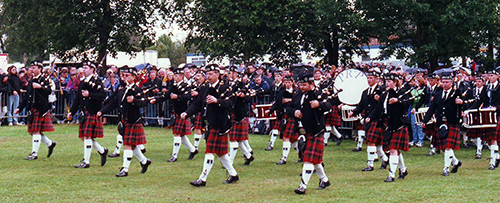The prestigious Wall Street Journal is used to frenzied activity, head to head battles, bears and bulls and all that. But this is as nothing to the fervid pipe band world they enter today with the following article on piper numbers. The article features comments from our Editor and other luminaries such as P/M Bill Livingstone formerly of the 78th Fraser Highlanders Pipe Band. Bill’s band is pictured above, so big that they struggled to fit in to the approach to the arena at the Worlds a few years back. Read on for the important parts of this story. The writer is the WSJ’s Michael M. Phillips….
 Is there such a thing as too many bagpipes? There’s a nagging suspicion, even among bagpipers, that the answer might be yes. Top-grade bagpipe bands used to compete at the World Pipe Band Championships in Glasgow, Scotland, with 10 or 12 pipers.
Is there such a thing as too many bagpipes? There’s a nagging suspicion, even among bagpipers, that the answer might be yes. Top-grade bagpipe bands used to compete at the World Pipe Band Championships in Glasgow, Scotland, with 10 or 12 pipers.
Now bands routinely march into the competition circle with 24 or even 27 pipers piping, and many pipers are worried the ballooning of the bands has gone too far……The Royal Scottish Pipe Band Association, which hosts the world championships, sets a minimum band size. Each Grade 1 one band – the top tier – must have at least eight pipers, three snare drummers and one bass drummer. The Association sets no upper limit, and therein lies the source of the arms race on the Glasgow Green.
‘Bands pressure each other to come up with a bigger unit, and size is perceived to matter,’ says Terry Lee, former pipe major of the Simon Fraser University Pipe Band of British Columbia. Not that everyone agrees on how it all started. Mitchell McDowell, who plays for Ontario’s City of Thorold Pipe Band, remembers his stunned disbelief when the Clan MacFarlane Pipe Band marched 18 bagpipes into the ballroom of a Toronto hotel for the 1979 Pipers’ and Pipe Band Society of Ontario Highland Ball.
[wds id=”6″]
Some pipers say a turning point came when Bill Livingstone, a lawyer from Whitby, Ontario, created the 78th Fraser Highlanders Pipe Band. Mr. Livingstone introduced new Celtic-and jazz-influenced music, played with aggressive abandon. In 1987, just five years after the band formed with just 11 pipers, it became the first non-Scottish entrant to win the Grade 1 World Championship, ending a six-year run by the Strathclyde Police Pipe Band. ‘All of a sudden the Scottish bands said, ‘We’re not going to let some foreigners come over here and show us up,’ says Bentley Wall, pipe major of Cleveland’s North Coast Pipe Band. ‘So the Scottish bands started recruiting to get larger bands with more players. Fraser responded by doing the same thing.’
The bagpipe has five pipes and an air bag. Traditionally, the bag has been made of sheep or goat skin and the reeds of Spanish cane. As the player blows, spittle collects in the bag and the reeds get wet. (Some pipers, known as dry blowers, have naturally un-humid breath.) A little moisture is necessary; a lot throws the bagpipe out of tune. It doesn’t help that the World Championships are held outdoors in a city that gets 170 days of rain a year. Pipe majors, who both play their own bagpipe and conduct the pipe and drum sections by tapping their foot, often spent an hour-and-a-half tuning a 14-person pipe band. Tuning a 27-piece pipe section was unthinkable back in the day. That changed with the advent of electronic tuners and Gore-Tex bags.

The Victoria Police Pipe Band out of Melbourne, Australia, caused a sensation by winning the world championship in 1998 using synthetic reeds. Then there’s the new moisture-control technology, which involves a microwavable product pipers call kitty litter. Now pipe majors, working with a tuning team, can tune 27 pipes in an hour. In 1995, Simon Fraser University won its first World Championship with 18 pipers. The band last won in 2009 with 24. In 2007, the 78th Frasers fielded a record 30 pipers, and had another half-dozen on the bench in case of injury or tuning troubles. The band finished fourth that year.
‘There’s a visual thing when they walk out on the playing surface and suddenly the audience and judges are confronted by this huge phalanx of pipers and drummers,’ says Robert Wallace, who edits pipingpress.com. ‘A small band is a loser before they even strike up.’ Mr. Wallace played for Muirhead & Sons Pipe Band, a Scottish powerhouse in the 1950s and 1960s. A huge pipe section can do justice to complex pieces such as ‘Journey to Skye’, which contain multiple musical parts. ‘Pipe bands are now playing at a level that was thought impossible due to the limitations of the bagpipe,’ says Andrew Carlisle, who runs the bagpipe programme at Carnegie Mellon University in Pittsburgh and has played 16 years with Northern Ireland’s Field Marshal Montgomery Pipe Band, 11-time world champs. The band won in 2016 with 27 pipers.
Big bands are also louder, something that appeals to players of an instrument one pipe major describes as having two volume settings: loud and off. Many pipers see a downside and are pressing for caps on roster size. Pressed to fill their ranks, they argue, Grade 1 bands are siphoning off talent from lower-ranked bands. In 2010, the Grade 1 City of Washington (D.C.) band dared take the field with just 10 pipers at the World Championships. ‘It wasn’t that bad of a play,” says Andrew Donlan, pipe major of the MacMillan United Pipe Bands in Washington, D.C. ‘But they didn’t have the numbers for the sound required for a Grade 1 band.’
Shortly afterward, the Royal Scottish Pipe Band Association downgraded City of Washington to Grade 2 and the band disbanded. The RSPBA demoted the Peel Regional Police Pipe Band, of Mississauga, Ontario, to Grade 2 last year after the band’s bottom-dwelling result at the World Championships. Peel Pipe Major John Cairns says he could field 14 or 15 top-notch pipers, including a few flown in from Australia. But he can’t round up the 20 or more he’d need to make a serious run in Glasgow.

Top players might travel thousands of miles to play with Grade 1 bands, with pipers from New Zealand and Australia traveling north to catch the summer season, and Americans, Canadians and Europeans migrating south. In pipingpress.com, Mr. Wallace called for a 20-pipe limit. Otherwise, bagpiping becomes a winner- take – all endeavor, with lower-ranked bands struggling to survive….. ‘Short on numbers and prospect of success, theirs is a sorry pursuit,’ he wrote. The decision is in the hands of the RSPBA, which effectively sets the standard. The 400 [band ] – member Scottish association shows no signs of giving in. ‘The majority appear to be happy with the current situation,’ says RSPBA Chief Executive Ian Embelton. ‘The guys with the winning pipe bands are the guys with the power,’ says Mr. Wallace. ‘Some say [limiting band size] would be suicide [for them]. Why would you change a set of rules that allow you to win world championships?’
Indeed, Scotland has developed a bagpipe programme in schools that promises a daunting supply of young talent. Carnegie Mellon now offers a master of music in bagpipe performance. Pennsylvania’s Edinboro University will offer a bagpipe performance minor this fall. Lyon College in Arkansas offers a minor in Scottish Arts, with the emphasis on bagpipe. Write to Michael M. Phillips at michael.phillips@wsj.com
Join the debate; take part in the PP poll on this important topic:[polldaddy poll=9642153]
[wds id=”3″]
















Bigger bands do not make more noise after a certain level of numbers has been arrived at. There has been a study on that. More players increases the risk of failing instruments, playing errors and bad blowing. Similar problems with many drummers. From the comments over the years I hear that 18/20 pipers is the optimum number. And a drum corps to match that size. Cutting numbers means cutting costs of drums, skins, pipe bags, chanters, reeds, uniforms (big issue) band buses and travel generally. Smaller practice rooms required and less cost all round. In these straightened times of the last decade where promoters are very scarce all of the above should be considered. The excess numbers could go on to form other pipe bands in all grades and to a higher standard. There is a dearth of good 1st and 2nd grade bands in Scotland in comparision with the latter half of the last century. Think on that. Then maybe we would not have to travel distances for practice etc. More local; more sociable and there is a dearth of the social aspect to bands now owing to folks having to cover distances to get back home. All work and no play makes Jack a dull boy. So get the numbers down and lets start enjoying our art. It’s easier too to do gigs as promoters of gigs are happy to pay for a smaller band. Ask the non-competing bands who are cornering that market.
Restricting piper and drummer numbers would be a good idea 16 – 18 seems reasonable. BUT would the players who get left out move to another band.A big issue is the absence of ‘leaders’ .Almost every time a leadership change comes the band goes down with one or two exceptions – too big bands could be a problem here – managing people is not easy. There is also a reluctance to my mind of experienced younger pipers stepping forward to take on Pipe Major roles.
The drive to be bigger and better siphons off talented musicians from lower grade bands working to move up in grade. Why play with a home grown Grade 4 on the cusp of being a 3 when one can make the jump to a higher grade by just jumping ship. I can’t tell you the number of pipers in our band who had great talent but chose to make the move to Grade 2 and 1 Bands because they wanted to be on the bigger stage now and had no interest in helping the band they started with work through the ranks each competition season. I warn bands all the time to be careful hiring G1 players as instructors. They’re only there to poach your better players.
I ceased subscription of The Piping Times some time ago. It looks as though I might start getting The Wall Street Journal as well as getting The Press and Journal!
Largest Pipe Band ? :
The Sutherland and Caithness Rifle Volunteers, which in 1908 became the 5th Territorial Battalion Seaforth Highlanders, had between 1890 and 1907 the largest pipe band in existence: seventy pipers and drummers played regularly, under Pipe Major Alexander D. Campbell.
Bands should put on their best 18 pipers max. This will push the standard up, as only the top 18 will make the cut. It also exposes the pipe corps more to judging scrutiny, to be smaller, and makes the whole competition more rigorous and fair. 6 to 8 sides max, and a couple of tenors and a bass. Just like any competitive team, numbers should be restricted. You can’t go play an 11 man rugby team and bring 65 players onto the field against them.